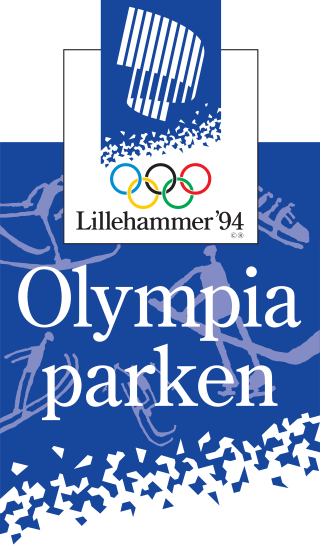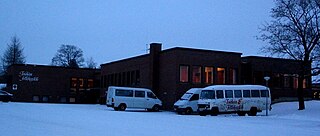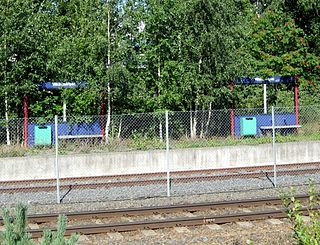
Hamar is a town in Hamar Municipality in Innlandet county, Norway. Hamar is the administrative centre of Hamar Municipality. It is located in the traditional region of Hedmarken. The town is located on the shores of Mjøsa, Norway's largest lake. Historically, it was the principal city of the former Hedmark county, now part of the larger Innlandet county.

The 1994 Winter Olympics, officially known as the XVII Olympic Winter Games and commonly known as Lillehammer '94, were an international winter multi-sport event held from 12 to 27 February 1994 in and around Lillehammer, Norway. Having lost the bid for the 1992 Winter Olympics to Albertville in France, Lillehammer was awarded the 1994 Winter Games on 15 September 1988, two days before the 1988 Summer Olympics opening ceremonies at the 94th IOC Session in Seoul, South Korea. Due to the calendar changes made in 1986, this was the only time that the Winter Olympics took place two years after the previous Winter Games, and the first to be held in a different year from the Summer Olympics. This was also the first Winter Olympics to be held during the Commonwealth Games year. This was the second Olympic Games of any type hosted in Norway — the first being the 1952 Winter Olympics in Oslo — and the fourth Olympics overall to be held in a Nordic country, after the 1912 Summer Olympics in Stockholm, Sweden, and the 1952 Summer Olympics in Helsinki, Finland. Lillehammer is the northernmost city ever to host the Olympic Games.

Håkons Hall, sometimes anglicized as Håkon Hall and Haakons Hall, is an arena located at Stampesletta in Lillehammer, Norway. With a spectator capacity of 11,500 people, it is the largest handball and ice hockey venue in the country. Håkons Hall is regularly used for handball and ice hockey tournaments, concerts, exhibitions, conferences and banquets. The venue is owned by Lillehammer Municipality via the subsidiary Lillehammer Olympiapark, which owns all the Olympic venues in Lillehammer. The Norwegian Olympic Museum is located in the arena, which is located next to the smaller Eidsiva Arena.

Vikingskipet, officially known as Hamar Olympic Hall, is an indoor multi-use sport and event venue in Hamar, Norway. It was built as the speed skating rink for the 1994 Winter Olympics, and has since also hosted events and tournaments in ice speedway, motorcycle speedway, rally, association football, bandy, ice sledge speed racing, flying disc and track cycling. The arena is also used for concerts, trade fair and the annual computer party The Gathering. It is the home arena of Hamar IL bandy team. The venue is owned by Hamar Municipality, and along with Hamar Olympic Amphitheatre is run by the municipal Hamar Olympiske Anlegg. Vikingskipet has a capacity for 10,600 spectators during sporting events and 20,000 during concerts.

Lysgårdsbakken, officially known as Lysgårdsbakkene Ski Jumping Arena, is a ski jumping hill in Lillehammer, Norway. It consists of a large hill, with a K-point of 123 and a hill size of 138, and a small hill with a K-point of 90 and a hill size of 98. It opened in 1993 for the 1994 Winter Olympics, where it hosted the ski jumping and Nordic combined events, as well as the opening and closing ceremonies. After the Olympics, ownership was transferred to the municipal Lillehammer Olympiapark and it has since been used for several FIS Ski Jumping World Cup and FIS Nordic Combined World Cup tournaments, including hosting the Nordic Tournament. It has a capacity for 35,000 spectators and is one of three national ski jumping hills in Norway. In 2007, the large hill was rebuilt to a larger profile, and received a new plastic lining. The venue sees 80,000 annual jumps in the winter and 20,000 in the summer season.

Gjøvik Olympic Cavern Hall is an ice hockey rink located within a mountain hall in Gjøvik, Norway. With a capacity for 5,500 spectators, the hall also features a 25-meter swimming pool and telecommunications installations. Opened in 1993 and costing 134.6 million Norwegian krone (NOK), it was built for the 1994 Winter Olympics, where it hosted 16 ice hockey matches. It is the home of Gjøvik Hockey, has hosted the 1995 World Short Track Speed Skating Championships and is also used as an event venue. The structure is the world's largest cavern hall for public use.

CC Amfi, also known as Nordlyshallen, is an indoor sports arena in Hamar, Norway. It is mostly used for ice hockey and is the home arena of Storhamar Hockey. It has also been used for short track speed skating, figure skating, handball, events and concerts. The venue has a capacity for 7,000 spectators and was built for the 1994 Winter Olympics, where it was used for short track speed skating and figure skating. Other major events held at the arena include the 1999 IIHF World Championship in ice hockey, the 1999 World Women's Handball Championship, the 2012 IPC Ice Sledge Hockey World Championships and the 2016 Winter Youth Olympics.

Eidsiva Arena, also known as Kristins Hall, is an arena located at Stampesletta in Lillehammer, Norway. It consist of an ice rink, a combined handball and floorball court, and a curling rink. The venue, owned and operated by the Lillehammer Municipality, opened in 1988 and cost 65 million Norwegian krone (NOK) to build. One of the motivations for its construction was to help Lillehammer's bid to be selected as the host of the 1994 Winter Olympics. The ice rink has a capacity for 3,194 spectators and is the home rink of GET-ligaen hockey club Lillehammer IK. Eidsiva Arena is located next to the larger Håkons Hall, which opened in 1993. During the 1994 Winter Olympics, Kristins Hall was a training rink, and subsequently hosted the ice sledge hockey tournament at the 1994 Winter Paralympics. The venue also co-hosted Group B of the 1989 World Ice Hockey Championships.

Stampesletta is a multi-use stadium complex in Lillehammer, Norway. Owned and operated by Lillehammer Municipality, it consists of a track and field venue, an artificial turf football field, three natural grass football fields, a gravel field and natural grass training pitches. In addition, it features a club house, locker facilities and a grandstand between the athletics and artificial turf fields. The venue is located about 1 kilometer (0.6 mi) from the town center, and serves as the home ground for the Second Division side Lillehammer FK, Lillehammer KFK, Roterud IL in football, and Lillehammer IF in athletics.

Lillehammer Olympic Bobsleigh and Luge Track is a bobsleigh, luge and skeleton track located at Hunderfossen in Fåberg, Norway, 15 kilometers (9 mi) north of the town center of Lillehammer. It was completed in 1992 for the 1994 Winter Olympics, where it hosted the bobsleigh events and luge events. It has since also hosted the FIBT World Championships 1995 in skeleton and the FIL World Luge Championships 1995, and hosted 2016 Winter Youth Olympics.

The 2016 Winter Youth Olympics, officially known as the II Winter Youth Olympic Games, took place in and around Lillehammer, Norway, between 12 February and 21 February 2016. They were the fourth Youth Olympic Games and the second winter edition. Lillehammer was awarded the games on 7 December 2011 as the only candidate. The games reused venues from the 1994 Winter Olympics; this made Lillehammer the first city to host both regular and Youth Olympics. In addition to Lillehammer, sports were contested in Hamar, Gjøvik and Øyer.

Birkebeineren Ski Stadium is a cross-country skiing and biathlon venue located in Lillehammer, Norway. Situated 3 kilometers (2 mi) from the town center and at 485 meters (1,591 ft) above mean sea level, it has two stadium areas, one for cross-country and one for biathlon. The former has a capacity for 31,000 spectators, and the latter for 13,500. The venue was built for the 1994 Winter Olympics, costing 83.6 million Norwegian krone (NOK). It was subsequently used by the 1994 Winter Paralympics for Paralympic Nordic skiing and Paralympic biathlon. After the games, ownership was transferred to the municipal Lillehammer Olympiapark. The venue has since been used for one Biathlon World Cup, three FIS Cross-Country World Cup and nine FIS Nordic Combined World Cup tournaments, the latter with the ski jumping competition taking place at the nearby Lysgårdsbakkene Ski Jumping Arena. Birkebeineren hosted the 2016 Winter Youth Olympics.

Kanthaugen Freestyle Arena is a freestyle skiing stadium located in the hillside area of Kanthaugen in Lillehammer, Norway. Opened in 1992, it was built for the 1994 Winter Olympics. The venue consists of three hills—one each for aerials, moguls and ski ballet. The moguls hill has a capacity for 12,000 spectators while the other two have a 15,000-person capacity. The arena is designated as Norway's national venue for freestyle skiing. It hosted the FIS Freestyle Skiing World Cup in 1993 and 1995, and is scheduled to host freestyle skiing and snowboarding at the 2016 Winter Youth Olympics. The arena is owned by Lillehammer Olympiapark and is located adjacent to the ski jumping hill Lysgårdsbakken.

Lillehammer Olympiapark AS, trading as Olympiaparken, is a company established following the 1994 Winter Olympics to operate the Olympic venues in Lillehammer, Norway. Owned by Lillehammer Municipality, it operates five sports venues: Birkebeineren Ski Stadium, Håkons Hall, Lillehammer Olympic Bobsleigh and Luge Track, Kanthaugen Freestyle Arena and the ski jumping hill of Lysgårdsbakken. In addition to serving sports events, the company provides tourist and group activities at the venues as well as catering to larger events.

The 1994 Winter Olympics were held in and around Lillehammer, Norway, from 12 to 27 February 1994. Ten competition and fourteen non-competition venues were used, most of which were subsequently used for the 1994 Winter Paralympics. The Games were spread out over ten venues in five municipalities in two counties, Oppland and Hedmark. Lillehammer, with approximately 25,000 inhabitants, and Hamar and Gjøvik, both with approximately 27,000 inhabitants, are all situated on the lake Mjøsa. Gjøvik and Hamar are 45 and 54 kilometers south of Lillehammer, respectively. Hunderfossen is 15 kilometers (9.3 mi) north of Lillehammer, but located within the municipality. Øyer and Ringebu, each with just under 5,000 inhabitants, are 18 and 50 kilometers north of Lillehammer, respectively, in the valley Gudbrandsdalen. Lillehammer had four competition venues, Hamar had two competition venues, while Hunderfossen, Gjøvik, Øyer and Ringebu had one competition venue each.

Hamar stadion is a former athletics, speed skating and bandy stadium in Hamar, Norway. The home ground of Hamar IL, it was owned by Hamar Municipality. It has held seven international speed skating events: the European Speed Skating Championships in 1934, 1948 and 1953, the World Allround Speed Skating Championships for Men in 1952 and 1985, and the World Allround Speed Skating Championships for Women in 1980 and 1991. The stadium has held 13 Norwegian Championships and 11 world records have been set at the venue.

Toneheim Folk High School is a folk high school located in Hamar, Norway, which focuses on music.

Vikingskipet Station was a temporary railway station located at Åkervika in Hamar, Norway, on the Røros Line. The station was officially opened on 16 August 1993, and was used during 1993 and 1994 to allow spectators direct access to the sports venue Vikingskipet for the 1993 UCI Track Cycling World Championships and the speed skating at the 1994 Winter Olympics, saving them a 1 kilometer (0.6 mi) walk from Hamar Station. The station is a cul-de-sac station which is electrified, unlike the rest of the Røros Line. Officially is a side track of Hamar Station, denoted track 42.

The 2016 Winter Youth Olympics in and around Lillehammer, Norway, between 12 February and 21 February 2016. Nine competition and twelve non-competition venues are to be used; all except the Youth Olympic Village in Lillehammer and a training ice rink being are existing venues. All the competition venues and some of the non-competition venues were built ahead of the 1994 Winter Olympics. The games be held in four municipalities: Lillehammer, Hamar, Gjøvik and Øyer.

Lillehammer is a town which is the administrative centre of Lillehammer Municipality in Innlandet county, Norway. The town is located along the river Gudbrandsdalslågen at the northern end of the lake Mjøsa in the southern Gudbrandsdal valley. Prior to the county merger on 1 January 2020, Lillehammer was the administrative centre of Oppland county.




















